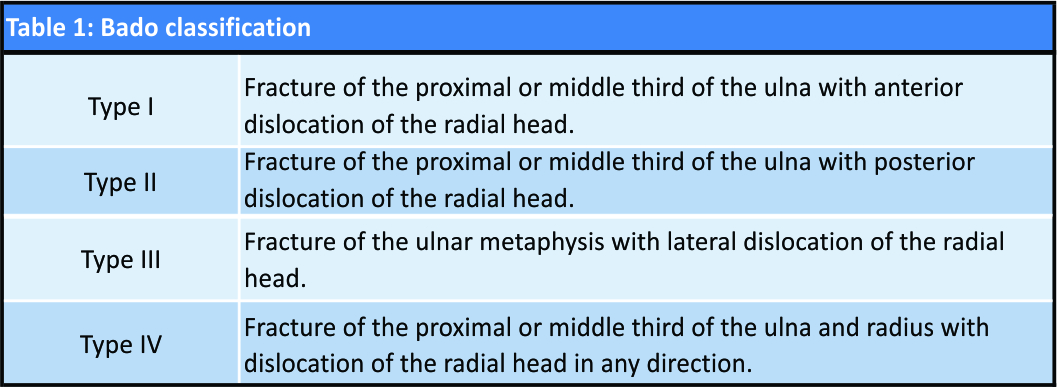[box type=”bio”] Learning Point of the Article: [/box]
Unstable fractures such as type III Monteggia lesion with ipsilateral fracture of the lateral condyle of humerus in children should be treated early and operatively.
Case Report | Volume 8 | Issue 5 | JOCR September – October 2018 | Page 19-21| Mark Bugeja, Arsen Avakyan, Eliezer Zahra Bianco, Thomas Azzopardi. DOI: 10.13107/jocr.2250-0685.1190
Authors: Mark Bugeja, Arsen Avakyan, Eliezer Zahra Bianco, Thomas Azzopardi
[1] Department of Trauma and Orthopaedics, Mater Dei Hospital, Triq Dun Karm, Msida MSD 2090, Malta.
Address of Correspondence:
Dr. Mark Bugeja,
Department of Trauma and Orthopaedics, Mater Dei Hospital, Triq Dun Karm, Msida MSD 2090, Malta.
E-mail: mark.a.bugeja@gov.mt
Abstract
Introduction: Monteggia fracture-dislocations are uncommon injuries in children, rarely associated with other ipsilateral upper limb injuries. We present a case of type III Monteggia lesion associated with an ipsilateral fracture of the lateral condyle of the humerus in a child.
Case Report: A 4-year-old girl presented with a left elbow swelling after falling from a height of 2 meters. X-rays showed a fracture of the proximal ulna with lateral dislocation of the radial head (type III Monteggia) associated with an ipsilateral fracture of the lateral condyle of the humerus. The fractures were treated by closed reduction of the radial head dislocation, percutaneous Kirschner wire fixation of the proximal ulna fracture, and open reduction and Kirschner wire fixation of the lateral condyle.
Conclusion: Monteggia fracture-dislocations are challenging both in terms of diagnosis and management and may lead to late disability of the elbow and forearm if not detected early and treated appropriately. Operative management, in this case, gave an excellent result. We recommend operative treatment in these complex elbow fractures.
Keywords: Monteggia fracture-dislocation, lateral condyle fracture, children, Kirschner wires.
Introduction
Monteggia fracture-dislocations are uncommon injuries, accounting for around 2% of all elbow fractures in children [1]. They are challenging both in terms of diagnosis and management and may lead to late disability of the elbow and forearm if not detected early and treated appropriately [2, 3]. In rare cases, the Monteggia fracture-dislocations are associated with other ipsilateral upper limb injuries in children [1, 3, 4, 5, 6, 7, 8]. We present a case of type III Monteggia lesion associated with an ipsilateral fracture of the lateral condyle of the humerus in a child, an extremely rare combination of injuries [4, 8].
Case Report
A 4-year-old, right-hand dominant girl presents to the accident and emergency department with pain and swelling in the left elbow after falling from a swing. She fell from a height of approximately 2 m, landing on to her left elbow. The patient was supporting the left elbow and forearm with her right hand at presentation. Clinical examination revealed swelling and bruising over the entire left elbow, with tenderness over the left olecranon and lateral epicondyle. Elbow movements were very painful. There was no neurological or vascular compromise of the left upper limb. Radiographic examination of the left elbow region revealed a fracture of the proximal ulna with lateral dislocation of the radial head (type III Monteggia equivalent lesion) associated with an ipsilateral fracture of the lateral condyle of the humerus (Fig. 1).
Discussion
The Monteggia fracture-dislocation was first described by Giovanni Batista Monteggia, an Italian surgeon in his book “Istituzioni Chirugiche,” in 1814 [9, 10].Monteggia noted that a fracture of the ulna was associated with a dislocation of the radial head and that they needed to be treated simultaneously [9, 10]. This fracture-dislocation type of injury was given its eponym in 1909 by Perrin [9]. In 1967, Jose Luis Bado classified these injuries under the term Monteggia lesion and described several Monteggia variations [9, 10]. This classification is comprised four types according to the direction of the radial head dislocation, together with the level and tilt of the proximal ulna fracture (Table 1) [9, 10]. Historically, during 1814–1939, the management of the injury by Giovanni Batista Monteggia, using closed reduction and casting resulted in recurrence of radial head dislocation and with suboptimal results [9]. During 1940–1990, with the introduction of implants, antibiotics and advances in anesthesia, open reduction, and internal fixation of the proximal ulna became possible [9].Except for Monteggia type IV, and difficult cases, Jose Luis Bado recommended non-operative management [9]. In contrast, Speed and Boyd, in their two publications (1940 and 1969), and Bruce et al., in 1974, recommended operative management for adults, and a non-operative management in children [9]. During this period, there was contradictory evidence regarding management of this injury [9]. Nowadays, closed reduction of the radial head, and open reduction with internal fixation of the proximal ulnar fracture, is the recognized management for Monteggia injury in adults [9]. In children, however, operative management is reserved for complex elbow injuries [9]. To the best of our knowledge, only two cases of type III Monteggia lesion with fracture of the lateral condyle were reported in literature. Dattani et al. reported a case involving a 3-year-old boy who underwent closed reduction of the radial head under general anesthesia, with the elbow immobilized for 4 weeks [4]. At 6 months, this boy achieved full range of movement at elbow, forearm, and wrist [4]. Park and Suh reported a similar injury in a 5-year-old girl, associated with radial nerve injury [8]. This was managed by open reduction and Kirschner wire fixation of lateral condyle fracture and a transcapitellar Kirschner wire fixation of radial head dislocation [8]. The ulna, however, was not fixed. We describe an operative management for these injuries, having a different technique than that described by Park and Suh [8]. The outcome of operative management in both cases was excellent. Dattani et al. had good functional results with non-operative management [4]. However, we recommend surgical management for this unstable combination of injuries, using percutaneous Kirschner wires to reduce the risk of further displacement and thus late disability.
Conclusion
Type III Monteggia lesions with ipsilateral fracture of the lateral condyle of the humerus in children are an exceptionally rare elbow injury. Early detection and the appropriate management are essential to avoid late disability of the elbow and forearm. This case highlights the importance of excluding other associated injuries when one elbow fracture is detected, as these are otherwise easily missed and overlooked. We strongly recommend surgical management in these types of elbow fractures.
Clinical Message
Type III Monteggia lesion with ipsilateral fracture of the lateral condyle of the humerus is an exceptionally rare elbow injury in children. For this unstable injury, we strongly recommend early detection followed by surgical management.
References
1. Song KS, Bae KC. Type III monteggia equivalent fracture with ipsilateral distal radial epiphyseal and ulnar metaphyseal fracture in a child. J Korean OrthopAssoc2004;39:563-5.
2. Gundavda MK, Chinoy RK. A case of an unusual Monteggia equivalent Type II with lateral condyle fracture. J Orthop2015;12:260-3.
3. Williams HL, Madhusudhan TR, Sinha A. Type III monteggia injury with ipsilateral type II salter harris injury of the distal radius and ulna in a child: A case report. BMC Res Notes 2014;7:156.
4. Dattani R, Patnaik S, Kantak A, Lal M. Distal humerus lateral condyle fracture and monteggia lesion in a 3-year old child: A case report. Acta OrthopBelg2008;74:542-5.
5. Kapil Mani KC, Sigdel A, Rayamajhi AJ. A rare combination injury of Type III monteggia fracture dislocation and ipsilateral epiphyseal fracture of distal radius in children. Is there a probability of missing the monteggia component? Chin J Traumatol2015;18:51-3.
6. Kara A, Kayaalp ME, Isyar M, Sever C, Malkoc M, Mahir M, et al. An undescribed monteggia Type 3 equivalent lesion: lateral dislocation of radial head with both-bone forearm fracture. Case Rep Orthop2016;2016:8598139.
7. Sinha S, Chang W, Campbell A, Sinha SS, Hussein S. Type III monteggia injury with ipsilateral distal radius and ulna fracture. Internet J Orthop Surg 2002;Volume 1 Number 2.
8. Park JH, Suh SW. Ipsilateral monteggia fracture and lateral condyle fracture of humerus in children. J Korean Soc Fract1997;10:708.
9. Rehim SA, Maynard MA, Sebastin SJ, Chung KC. Monteggia fracture dislocations: A historical review. J Hand Surg Am 2014;39:1384-94.
10. Wiley JJ, Galey JP. Monteggia injuries in children. J Bone Joint Surg Br 1985;67:728-31.
 |
 |
 |
 |
| Dr. Mark Bugeja | Dr. Arsen Avakyan | Dr. Eliezer Zahra Bianco | Mr. Thomas Azzopardi |
| How to Cite This Article: Bugeja M, Avakyan A, Bianco E Z, Azzopardi T. Type III Monteggia Equivalent Lesion with Ipsilateral Fracture Lateral Condyle of Humerus in a Four-year-old Child: A Case Report and Literature Review. Journal of Orthopaedic Case Reports 2018 Sep-Oct; 8(5): 19-21. |
[Full Text HTML] [Full Text PDF] [XML]
[rate_this_page]
Dear Reader, We are very excited about New Features in JOCR. Please do let us know what you think by Clicking on the Sliding “Feedback Form” button on the <<< left of the page or sending a mail to us at editor.jocr@gmail.com






